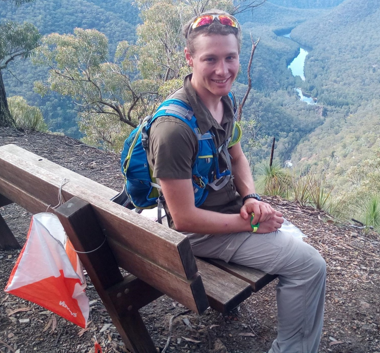
A 24-hour rogaine looks a lot like a semester of university. The pace at the beginning is fast, but it doesn’t take long for motivation to drop off and slogging away becomes a test of willpower. And just like the final hours of an assignment, or final minutes of an exam, the adrenaline kicks in and a rogainer will fight tooth and nail to collect whatever points they can before the deadline, which is inevitably reached in a panic with minutes to spare, if at all. Both cases also include having to push through all-nighters and having to deal with the highs and lows of team dynamics with frank exchanges between individuals who may have very different philosophies on how to solve the problem.
Despite these parallels, I was amazed at how few university students in NSW were into rogaining during my own days at uni between 2012 and 2016. In multiple years I contacted various outdoors-related clubs trying to get some poor sucker into the Invervarsity Champs with me, to no avail (they told me it was “too serious” for their members).
Let us fast forward to 2020, and I introduce Salomé Hussein, who in recent months has hit up the University of Technology Sydney Outdoor Adventure Club and gotten many of them into rogaining in a big way. She takes this chance to share some of her experiences in the club and share her insights on the sport.
Tristan White: Where have you previously lived and what do you do with your life when not rogaining?
Salomé Hussein: I was born in Eugene, Oregon (USA), then moved to Tijeras, New Mexico and Palm Beach, Florida, before settling in Eagle River, Alaska for 8 years. At age 21, I moved to Auckland to get my PhD in physics, designing spray systems for agricultural robotics. I moved to Sydney in late 2018 for a job modelling natural catastrophes with Risk Frontiers as a data scientist. I use languages like Python and R to process climate data. (We don’t model pandemics, yet, at least!)
I also play flute in North Shore Wind Symphony, rock-climb and dabble in most other long-distance sports including cycling and swimming. That tends to not leave me with much free time, but enough to go to an adoptive family’s art studio and pretend I can draw, and I hack apart hobbyist electronics when the urge hits me.
TW: Tell us your story about getting into rogaining and the UTS Outdoor Adventure Club, given you’re not even a UTS student.
SH: I joined UTS OAC for rock-climbing partners I could trust as I hadn’t been having great luck. A former UTS OAC president was the Australian School of Mountaineering instructor that first taught me how to climb outdoors, and he suggested I join his old club. The then webmaster posted about a rogaine – the 2019 Springwood Metrogaine. I had just agreed to take on the webmaster role and saw the event as a chance to have a good chat to him without even properly understanding what the sport was about!
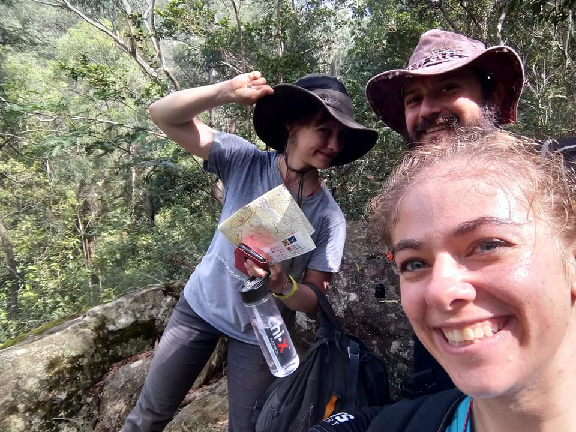
When we were first handed the map, I was immediately overwhelmed and confused. Although the notes had a suggested novice route, just trying to locate the control circles on the map felt like information overload. I felt like a sheep and wandered to the first few controls with the starting swarm. Once we’d gotten a few controls, I started to really enjoy myself, particularly the rapid decision-making we had to make towards the end as to whether we’d go for extra controls or make it back without penalty. I even enjoyed that we had to spontaneously break into a trail run despite still ending up with a late deduction.
I loved that the attendees ranged from young families, to ultra-marathoners to old retired couples, to awkward young women like me. The activity has a little something for everyone; it can be just a fun family outing or the pinnacle of an entire season’s training after many years of practice. I also enjoy that the courses themselves take me places I wouldn’t have normally gone.
TW: What is the UTS OAC and what does it do?
SH: The club is entirely volunteer based, and has about 400-450 members of which a small proportion are extremely engaged and ultimately become trip leaders and/or committee members. The leadership is older than an average uni club, so there’s far more emphasis on safety. Trip leaders go through a documented vetting process and get one-on-one mentoring by more experienced trip leaders. We have a database of which students have taken certain skills courses, so that leaders only accept people with a knowledge base they’re comfortable being responsible for.
Every Monday, a group of members climbs at The Ledge, the climbing gym at the USyd fitness centre, which functions as our club house, as it does for the other university outdoor/climbing clubs as well. Being without family and moving to a new country, I’ve benefitted tremendously from dropping in and finding a group of caring, welcoming people that have been keen to teach me and trust me. I’ve quickly felt right at home in Australia with my family of explorers.
Rogaining has always in the periphery of the club. However, Nicole Mealing still champions the activity with us and in recent times we have seen an increased interest and participation from our members.
TW: What is your role in UTS OAC?
SH: I have a couple of roles. I’m their webmaster, and I’m also one of their trip leaders, which fundamentally means I’m willing to post and organise trips for other members, and I take some responsibility for their safety, education, and enjoyment. I’m one of the main faces posting navigation related trips at the moment, but my team-mates have stepped up to the plate and are relieving me on that front. I also teach basic rope-skills, like abseiling and introduction to outdoor climbing.
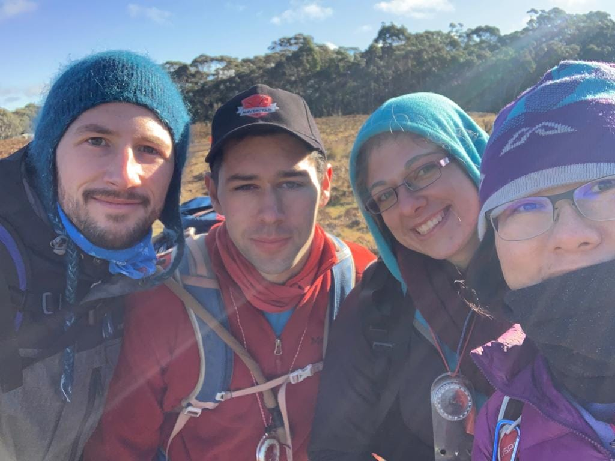
Many of the people you get on those introductory outings are either international students or students who don’t actually self-identify as “outdoorsy.” Indeed, that moniker is a product of environment, upbringing, and socio-economic status. Something I personally factor into my leadership is to stay conscious of an opportunity to show people what they’re capable of and change how they see themselves. I’ve been in dark places mentally, and certain people made a world of difference to me and my mindset. I try to do the same for others.
TW: How did the OAC get into rogaines in the first instance, and what rogaines have they gotten teams together for in the past few years?
SH: The OAC’s first rogaine is probably lost to history, but I suspect the founders would’ve been drawn to it. One I’ve met recently is a fellow geeky athlete; the classic rogaining type.
Since I’ve joined in 2019, we’ve done the Springwood Metrogaine, Navshield, Nyctophobia Buster, NSW Champs, Oz Champs in Tasmania, and this year’s Narrabeen Minigaine. Some members did the Sydney Summer Series, though I only managed three before injury took me out. On this year’s Queen’s Birthday weekend, we tested out the MapRunF Nyctophobia course.
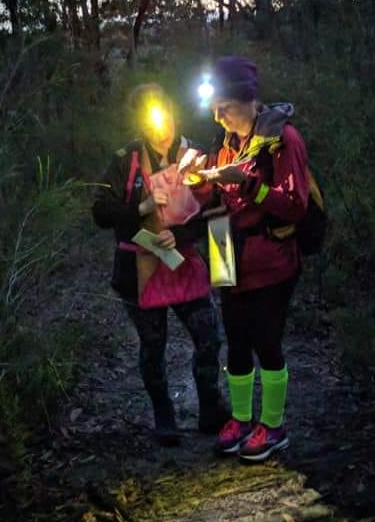
TW: What sort of experiences have OAC members had at rogaines during your time and what have you learned?
SH: My major high has been the crew I got together for Navshield. I talked a few ClimbFit buddies into it. I was the only one in the team who’d done a past rogaine. I reassured them it was a newbie friendly sport and they really didn’t need much experience. Then club president, Susan, also joined up, partly for moral support. I named us the Godwits because they migrate from Alaska to New Zealand, like I did – longest known non-stop journey by any bird.
These folks were and are still the best team-mates I could ask for in terms of learning, attitude, and cooperation. They took everything that event threw at us in stride, including the frigid conditions. I surprised teammate Adam with a birthday cake by the fire, and we had fun cooking absurd meals in the firepit itself. The next morning was -5°C and the first time I’d seen snow since leaving Alaska and I almost wept.
The next highlight I recall was turning off our headlamps and strolling by moonlight back to the HH at the Oz champs in Tasmania.
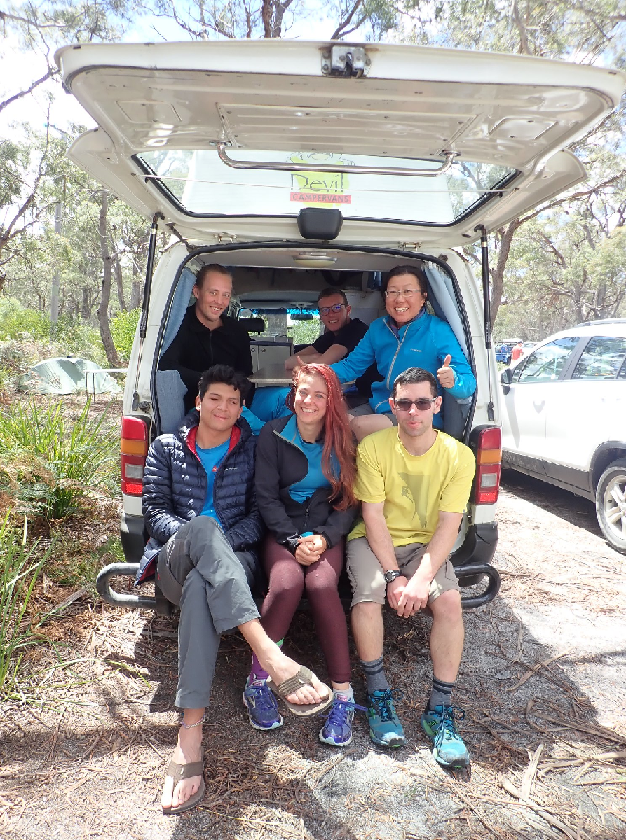
But it’s not been all that straightforward. I recruited a whopping four teams to the NSW Champs in Yengo. While one novice team won in their category, another leader and I took a different team of younger novices. One member coaxed the others into choosing the harder of suggested routes. The other three were chatty and inattentive, and blazed by obvious turnoff points. They ended up being the sort who needed guidance on how to behave in the outdoors. They didn’t have enough water, know what sort of shoes are appropriate, and would drop fruit peels on the ground. Nonetheless, they still had a good time, which was a key goal for the trip.
A UTSOAC team were disqualified at the Oz champs for separating. That was a clash of personalities I just didn’t anticipate. Two members were fitter and more determined but didn’t heed the needs of the other two and ultimately abandoned their slower teammates! The slower pair flagged down a patrol for a lift back to camp!
TW: You’ve taking some OAC students out on course from previous rogaines for training exercises. Tell us about that.
SH: I wanted people to get a feel for things before they were out on course at Tasmania. We’re normally dealing with international students, so an interstate trip like that is a big deal financially. I knew they’d have a better experience if they knew each other better and had more of an idea what to expect, so we went out on the 2018 Berowra Socialgaine course, the Lane Cove/Marsfield (River Rumble?) course, and the permanent orienteering courses at Centennial and Olympic Parks.
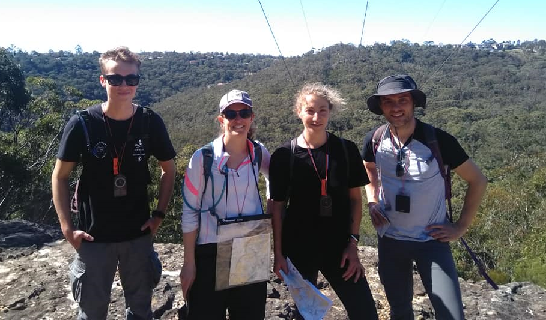
I intend to do those again, especially at the start of semesters. I think people who aren’t accustomed to being in a “competition” for the fun of it get put off a bit by the notion of entering a race or game, and still others aren’t necessarily keen to put down money for something they assume they’re bad at. It feels safer and less committing or embarrassing to just turn up to one of my trips with a few other people and talk over a map for a few hours.
My approach with them varies wildly depending on the expertise of who comes. I’m good at adjusting on the fly though. Some people are experienced outdoorsmen and independent personalities. I explain basics, offer pointers, then let them plan a route themselves. If anything, I only intervene at that point if somebody has gone quiet to make sure that person is staying engaged. I’m also still learning, so once we’re out and searching for control locations I try to behave more like they’re my team-mates, which usually encourages more independence from them.
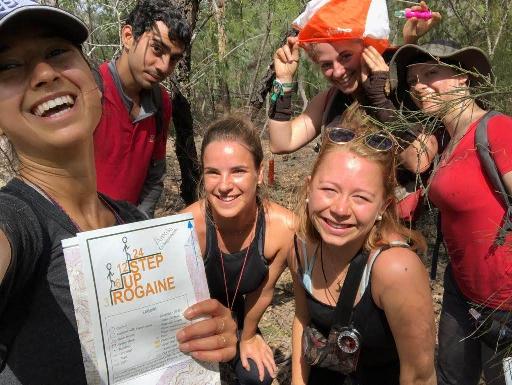
TW: Tell us about the workshops that you’re running for the students, and how have they been received so far? What other topics are to come?
SH: Normally, our skills courses have defined curriculum and progression, including rockclimbing, abseiling and hiking.
Over the lockdown period, I prepared a series of four navigation skills workshops. The first two pieces were foundational, reading maps, and compass work. In terms of delivery of material, I enjoyed getting creative and using images and maps from all over the world. I ended up showing maps onto my computer monitor, then using a tablet on the same Zoom call, to video me using the compass on the monitor. The attendees said that worked fine!
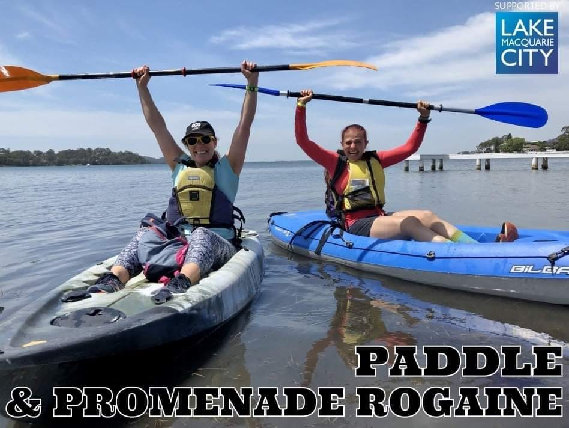
The last two workshops discussed the differences between the different types of competitive navigation, and the final one was a more nuanced look into rogaining – or more generally, longer duration adventure events.
TW: I enjoyed helping you with that too. Do you have any tips for uni students who are struggling to get a similar program off the ground at their campus?
SH: Having started clubs on my own, for different things, I found it’s both more rewarding and practical to build your initial group of members first, before you worry about the bureaucratic nonsense. If you have 3-5 keen, reliable people, a couple more drifters, and you build up your collective experience and psyche, it’s impossible for the relevant bodies at your school to shrug you off. Institutions tend to provide more barriers, in terms of formalities (i.e. paperwork/restrictions), rather than support you, at least initially. Later on, as you start to need official means to manage it, then their support and protection becomes useful.
TW: Thanks Sam for your story, advice and exuberance.